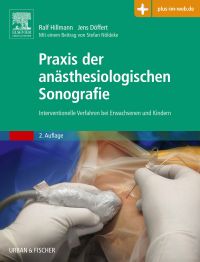Allgemeine anästhesiologische Sonograf e . . . . . . . . . . . . 1
1 Einführung in Technik und Praxis der Sonografie . . . . . . . . . . . . . . . . . . . . . . . . . . . . . 3
1.1 Physikalische Grundlagen . . . . . . . . . . . . . . . . . . 3
1.1.1 Erzeugung, Senden und Empfangen von Schallwellen . . . . . . . . . . . . . . . . . . . . . . . . . . . . . 3
1.1.2 Abbildungsmöglichkeiten des Ultraschalls . . . . . . . 9
1.1.3 Artefakte im Ultraschall . . . . . . . . . . . . . . . . . . . . . 9
1.2 Spezielle Ultraschallverfahren . . . . . . . . . . . . . . . 12
1.2.1 Doppler-Verfahren (CW- und PW-Doppler) . . . . . . . 12
1.2.2 Duplex-Sonografie . . . . . . . . . . . . . . . . . . . . . . . . . 13
1.2.3 Farbkodierte Duplex-Sonografie . . . . . . . . . . . . . . . 14
1.2.4 Power-Doppler-Verfahren . . . . . . . . . . . . . . . . . . . 14
1.2.5 Gewebe-Doppler (Tissue-Doppler) . . . . . . . . . . . . . 15
1.2.6 Kontrastmittelultraschall (CEUS) . . . . . . . . . . . . . . 15
1.2.7 3D-Ultraschall . . . . . . . . . . . . . . . . . . . . . . . . . . . . 15
1.2.8 Endosonografie (speziell TEE) . . . . . . . . . . . . . . . . 15
1.3 Schallkopftypen und Einsatzbereiche . . . . . . . . . . 16
1.3.1 Linearscanner . . . . . . . . . . . . . . . . . . . . . . . . . . . . 16
1.3.2 Konvexscanner . . . . . . . . . . . . . . . . . . . . . . . . . . . 17
1.3.3 Sektorscanner . . . . . . . . . . . . . . . . . . . . . . . . . . . . 17
1.3.4 Phased-array-Scanner . . . . . . . . . . . . . . . . . . . . . . 17
1.3.5 TEE-Sonde . . . . . . . . . . . . . . . . . . . . . . . . . . . . . . 18
1.3.6 Spezialsonden . . . . . . . . . . . . . . . . . . . . . . . . . . . . 18
1.4 Aufbau eines Ultraschallgeräts . . . . . . . . . . . . . . 18
1.4.1 Analog-Digital-Wandler . . . . . . . . . . . . . . . . . . . . . 18
1.4.2 Preprocessing . . . . . . . . . . . . . . . . . . . . . . . . . . . . 18
1.4.3 Postprocessing . . . . . . . . . . . . . . . . . . . . . . . . . . . 18
1.4.4 Tiefenausgleich . . . . . . . . . . . . . . . . . . . . . . . . . . . 18
1.4.5 Verstärkung (Gain) . . . . . . . . . . . . . . . . . . . . . . . . 19
1.4.6 Fokussierung . . . . . . . . . . . . . . . . . . . . . . . . . . . . . 19
1.4.7 Digitale Bildverarbeitung . . . . . . . . . . . . . . . . . . . . 20
1.4.8 Digitaler Bildaufbau . . . . . . . . . . . . . . . . . . . . . . . 20
1.5 Praxis der Ultraschallverfahren . . . . . . . . . . . . . . 21
1.5.1 B-Mode . . . . . . . . . . . . . . . . . . . . . . . . . . . . . . . . 21
1.5.2 Farb-Doppler/Power-Doppler . . . . . . . . . . . . . . . . . 21
1.5.3 Gepulster Doppler (PW-Doppler) . . . . . . . . . . . . . . 21
1.5.4 M-Mode . . . . . . . . . . . . . . . . . . . . . . . . . . . . . . . . 21
1.5.5 Transösophageale Untersuchung (TEE) . . . . . . . . . . 21
1.5.6 Checkliste Geräteeinstellung . . . . . . . . . . . . . . . . . 22
1.5.7 Befunderstellung/Dokumentation . . . . . . . . . . . . . 22
2 Sonografische Untersuchungstechnik . . . . . . 23
2.1 Untersuchungsgang . . . . . . . . . . . . . . . . . . . . . . . 23
2.1.1 Ultraschallsicherheit . . . . . . . . . . . . . . . . . . . . . . . 23
2.1.2 Patientenlagerung . . . . . . . . . . . . . . . . . . . . . . . . . 24
2.1.3 Positionierung des Ultraschallgeräts . . . . . . . . . . . . 25
2.1.4 Handhabung des Schallkopfs . . . . . . . . . . . . . . . . . 26
2.1.5 Schallkopfachsen und Nadel-Schallkopfausrichtung
2.1.6 Spezielle Artefakte und Besonderheiten der interventionellen Sonografie . . . . . . . . . . . . . . 34
2.2 Hygieneempfehlungen für interventionelle Verfahren . . . . . . . . . . . . . . . . . . . . . . . . . . . . . . . 37
2.2.1 Konventionelle Regionalanästhesie und Gefäßpunktion . . . . . . . . . . . . . . . . . . . . . . . . . . . 37
2.2.2 Ultraschallgesteuerte Regionalanästhesie und Gefäßpunktion . . . . . . . . . . . . . . . . . . . . . . . . . . . 37
II Spezielle anästhesiologische Sonografie . . . . 43
3 Sonografi sch gesteuerte Anlage von Gefäßzugängen . . . . . . . . . . . . . . . . . . . . . . . . . 45
3.1 Sonografi sche Merkmale von Gefäßen . . . . . . . . 45
3.2 Zentralvenöse Zugänge . . . . . . . . . . . . . . . . . . . . 48
3.2.1 Besonderheiten beim pädiatrischen Patienten . . . . 49
3.2.2 Vena jugularis interna . . . . . . . . . . . . . . . . . . . . . . 49
3.2.3 Vena subclavia . . . . . . . . . . . . . . . . . . . . . . . . . . . 55
3.2.4 Vena femoralis . . . . . . . . . . . . . . . . . . . . . . . . . . . 62
3.3 Periphervenöse Zugänge . . . . . . . . . . . . . . . . . . . 65
3.4 Arterielle Zugänge . . . . . . . . . . . . . . . . . . . . . . . . 68
3.4.1 Arteria radialis . . . . . . . . . . . . . . . . . . . . . . . . . . . 69
4 Sonografi sch gesteuerte Regionalanästhesie . . . . . . . . . . . . . . . . . . . . . 77
4.1 Besonderheiten beim pädiatrischen Patienten . . . 78
4.2 Plexus brachialis . . . . . . . . . . . . . . . . . . . . . . . . . 80
4.2.1 Interskalenärer Zugang . . . . . . . . . . . . . . . . . . . . . 82
4.2.2 Alternativverfahren zur Blockade des interskalenären Plexus . . . . . . . . . . . . . . . . . . . . . . 91
4.2.3 Supraklavikulärer Zugang . . . . . . . . . . . . . . . . . . . 96
4.2.4 Infraklavikulärer Zugang . . . . . . . . . . . . . . . . . . . . 101
4.2.5 Axillärer Zugang . . . . . . . . . . . . . . . . . . . . . . . . . . 105
4.2.6 Hauptnervenstämme des Plexus brachialis . . . . . . . 113
4.3 Plexus lumbosacralis . . . . . . . . . . . . . . . . . . . . . . 120
4.3.1 Nervi iliohypogastricus et ilioinguinalis . . . . . . . . . 123
4.3.2 Nervus cutaneus femoris lateralis . . . . . . . . . . . . . . 126
4.3.3 Nervus femoralis . . . . . . . . . . . . . . . . . . . . . . . . . . 129
4.3.4 Nervus saphenus . . . . . . . . . . . . . . . . . . . . . . . . . . 134
4.3.5 Nervus obturatorius . . . . . . . . . . . . . . . . . . . . . . . . 139
4.3.6 Nervus ischiadicus . . . . . . . . . . . . . . . . . . . . . . . . . 143
4.3.7 Periphere Blockaden der unteren Extremität, Fußblock . . . . . . . . . . . . . . . . . . . . . . . . . . . . . . . . 157
4.4 Bauchwand . . . . . . . . . . . . . . . . . . . . . . . . . . . . . 166
4.4.1 Transversus-Abdominis-Plane-Block (TAP-Block) . . 166
4.4.2 Nervi iliohypogastricus et ilioinguinalis . . . . . . . . . 171
4.4.3 Rektusscheiden-Block . . . . . . . . . . . . . . . . . . . . . . 171
4.5 Plexus cervicalis . . . . . . . . . . . . . . . . . . . . . . . . . . 173
4.6 Neuroaxiale Verfahren . . . . . . . . . . . . . . . . . . . . . 178
4.6.1 Lumbale und thorakale Periduralanästhesie . . . . . . 178
4.6.2 Kaudalanästhesie . . . . . . . . . . . . . . . . . . . . . . . . . 183
4.7 Ultraschallgesteuerte wirbelsäulennahe Interventionen in der Schmerztherapie . . . . . . . . 189
4.7.1 Wurzelinfi ltration . . . . . . . . . . . . . . . . . . . . . . . . . 189
4.7.2 Facetteninfi ltration . . . . . . . . . . . . . . . . . . . . . . . . 191
4.7.3 Blockade des Ganglion cervicothoracicum (stellatum) . . . . . . . . . . . . . . . . . . . . . . . . . . . . . . 194
4.7.4 Infi ltration des Iliosakralgelenks . . . . . . . . . . . . . . . 197
4.7.5 Infi ltration des Musculus piriformis . . . . . . . . . . . . 198
4.7.6 Thorakale Paravertebralblockade . . . . . . . . . . . . . . 202
5 Interventionelle sonografi sche Verfahren in der Intensivmedizin . . . . . . . . . . . . . . . . . . . 211
5.1 FAST (Focussed Abdominal Sonography in Trauma) . . . . . . . . . . . . . . . . . . . . . . . . . . . . . . 211
5.2 Pleurapunktion . . . . . . . . . . . . . . . . . . . . . . . . . . 219
5.3 Suprapubischer Blasenkatheter . . . . . . . . . . . . . . 223
5.4 Dilatationstracheotomie . . . . . . . . . . . . . . . . . . . 229
Register . . . . . . . . . . . . . . . . . . . . . . . . . . . . . . . 23








